International Journal of Intelligent Systems and Applications @ijisa
Статьи журнала - International Journal of Intelligent Systems and Applications
Все статьи: 1214
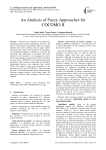
An Analysis of Fuzzy Approaches for COCOMO II
Статья научная
Software cost estimation is one of the most challenging task in project management. However, the process of estimation is uncertain in nature as it largely depends upon some attributes that are quite unclear during the early stages of development. In this paper a soft computing technique is explored to overcome the uncertainty and imprecision in estimation. The main objective of this research is to investigate the role of fuzzy logic technique in improving the effort estimation accuracy using COCOMO II by characterizing inputs parameters using Gaussian, trapezoidal and triangular membership functions and comparing their results. NASA (93) dataset is used in the evaluation of the proposed Fuzzy Logic COCOMO II. After analyzing the results it had been found that effort estimation using Gaussian member function yields better results for maximum criterions when compared with the other methods.
Бесплатно
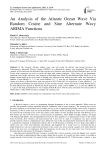
An Analysis of the Atlantic Ocean Wave Via Random Cosine and Sine Alternate Wavy ARIMA Functions
Статья научная
In this research, alternate random wave sine and cosine for discrete time-varying processes via Autoregressive Integrated Moving Average (ARIMA) in a deterministic manner were developed. The mean and variance of the cosine and sine periodical time-varying wavy functions were derived such that Maclaurin series via full Taylor series expansion was used to rewrite the mean and variance functions. Wavy buoys of sea temperature, significant wave height, and mean wave direction of Belmullet Inner (Berth B) and Belmullet Outer (Berth A) of the Atlantic Ocean based on the west coastal of Ireland were subjected to the random sine and cosine wave functions of ARIMA. Cosine-ARIMA (1, 1, 3) and cosine-ARIMA (0, 1, 1) were the sea temperature inner and outer oceanic climate wave buoys of Berth B and A with time-periods of 8437.5 and 8035.714 respectively. Cosine-ARIMA (5, 1, 0) gave minimum performance for peak direction of inner and outer oceanic climate wave buoys of both Berth B and A, but with different time-periods of 168750 and 56250 respectively. Lastly, cosine-ARIMA (2, 1, 2) and sine-ARIMA (0, 1, 5) put in the ideal generalization for wave height of Berth B and A with the same associated wave time-periods of 56250, that is, it takes 56250 seconds to complete one swaying cycle.
Бесплатно
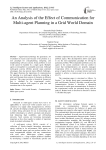
An Analysis of the Effect of Communication for Multi-agent Planning in a Grid World Domain
Статья научная
Agent-based technology has generated a lot of attention in recent years because of its promise as a new paradigm for conceptualizing, designing, and implementing software systems. Some problems in real world cannot be handled by a single agent. Multiple agents work together to accomplish some task. Although multi-agent systems (MASs) provide many potential advantages, they also present many difficult challenges. This paper illustrates the importance of communication for planning in a multi-agent setting by considering a grid world domain that consists of obstacles at different locations. This paper provides a theoretical framework that is validated by the experimental results. Performance analysis with respect to plan size and execution time is also reported.
Бесплатно
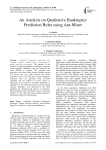
An Analysis on Qualitative Bankruptcy Prediction Rules using Ant-Miner
Статья научная
Qualitative bankruptcy prediction rules represent experts' problem-solving knowledge to predict qualitative bankruptcy. The objective of this research is predicting qualitative bankruptcy using ant-miner algorithm. Qualitative data are subjective and more difficult to measure. This approach uses qualitative risk factors which include fourteen internal risk factors and sixty eight external risk factors associated with it. By using these factors qualitative prediction rules are generated using ant-miner algorithm and the influence of these factors in bankruptcy is also analyzed. Ant-Miner algorithm is a application of ant colony optimization and data mining concepts. Qualitative rules generated by ant miner algorithm are validated using measure of agreement. These prediction rules yields better accuracy with lesser number of terms than previously applied qualitative bankruptcy prediction methodologies.
Бесплатно
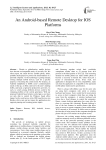
An Android-based Remote Desktop for IOS Platforms
Статья научная
Thanks to globalization, mobile devices have become an inseparable entity of our daily life. We often expect our smart devices (mobile phone, tablet, portable media player) to possess the functionalities of a personal computer. As the technology is getting cheaper, owning multiple mobile devices, each for a specific purpose, is becoming the current trend. For instance, an Android smartphone to fulfill a user’s communication needs on-the-go, an iPad could serve the user’s reading hobby, and lastly, a laptop for productivity activities. As such, to switch among different devices could be the emerging problem of the current generation. With our proposed Android based remote control app, a user does not only able to control his Windows based office laptop, but he could access to his IOS based devices too. Besides click event and text input, this application also supports panning and zooming gesture inputs.
Бесплатно
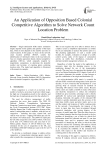
Статья научная
Origin–destination (OD) matrix estimation largely depends on the quality and quantity of the input data, which in turn depends on the number and sites of count locations. In this paper, we focus on the network count location problem (NCLP), namely the identification of informative links in the road network. Also we employ opposition based colonial competitive algorithm (OCCA), which originally inspired by imperialistic competition, to determine the desirable number and locations of counting points satisfying location rules. The model and algorithm is illustrated with numerical examples.
Бесплатно
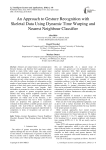
Статья научная
Gestures are natural means of communication between humans, and therefore their application would benefit to many fields where usage of typical input devices, such as keyboards or joysticks is cumbersome or unpractical (e.g., in noisy environment). Recently, together with emergence of new cameras that allow obtaining not only colour images of observed scene, but also offer the software developer rich information on the number of seen humans and, what is most interesting, 3D positions of their body parts, practical applications using body gestures have become more popular. Such information is presented in a form of skeletal data. In this paper, an approach to gesture recognition based on skeletal data using nearest neighbour classifier with dynamic time warping is presented. Since similar approaches are widely used in the literature, a few practical improvements that led to better recognition results are proposed. The approach is extensively evaluated on three publicly available gesture datasets and compared with state-of-the-art classifiers. For some gesture datasets, the proposed approach outperformed its competitors in terms of recognition rate and time of recognition.
Бесплатно
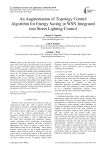
Статья научная
Energy saving and improve the life time of the sensor node is main focus in the recent years for the researchers hence one of the application domain (Street light monitoring and controlling) of sensor required attention towards this direction. For contributing in this domain we have proposed a scheme for Street light controlling using distributed topology control (TC). The optimize version of A3 protocol reduces the number of messages send/received by the sensors which ultimately leads to the reduction of energy requirement. Experiments are carried on street light scenario for different no. of nodes by maintaining communication using Zigbee protocol. The performance of our extension is evaluated using, no. of messages send/receive & energy consumed during topology building and our approach is having good results as compared to the approach used for this type of network.
Бесплатно
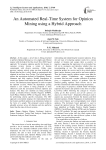
An Automated Real-Time System for Opinion Mining using a Hybrid Approach
Статья научная
In this paper, a novel idea is being presented to perform Opinion Mining in a very simple and efficient manner with the help of the One-Level-Tree (OLT) based approach. To recognize opinions specific for features in customer reviews having a variety of features commingled with diverse emotions. Unlike some previous ventures entirely using one-time structured or filtered data but this is solely based on unstructured data obtained in real-time from Twitter. The hybrid approach utilizes the associations defined in Dependency Parsing Grammar and fully employs Double Propagation to extract new features and related new opinions within the review. The Dictionary based approach is used to expand the Opinion Lexicon. Within the dependency parsing relations a new relation is being proposed to more effectively catch the associations between opinions and features. The three new methods are being proposed, termed as Double Positive Double Negative (DPDN), Catch-Phrase Method (CPM) & Negation Check (NC), for performing criteria specific evaluations. The OLT approach conveniently displays the relationship between the features and their opinions in an elementary fashion in the form of a graph. The proposed system achieves splendid accuracy across all domains and also performs better than the state-of-the-art systems.
Бесплатно
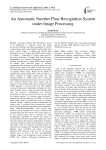
An Automatic Number Plate Recognition System under Image Processing
Статья научная
Automatic Number Plate Recognition system is an application of computer vision and image processing technology that takes photograph of vehicles as input image and by extracting their number plate from whole vehicle image , it display the number plate information into text. Mainly the ANPR system consists of 4 phases: - Acquisition of Vehicle Image and Pre-Processing, Extraction of Number Plate Area, Character Segmentation and Character Recognition. The overall accuracy and efficiency of whole ANPR system depends on number plate extraction phase as character segmentation and character recognition phases are also depend on the output of this phase. Further the accuracy of Number Plate Extraction phase depends on the quality of captured vehicle image. Higher be the quality of captured input vehicle image more will be the chances of proper extraction of vehicle number plate area. The existing methods of ANPR works well for dark and bright/light categories image but it does not work well for Low Contrast, Blurred and Noisy images and the detection of exact number plate area by using the existing ANPR approach is not successful even after applying existing filtering and enhancement technique for these types of images. Due to wrong extraction of number plate area, the character segmentation and character recognition are also not successful in this case by using the existing method. To overcome these drawbacks I proposed an efficient approach for ANPR in which the input vehicle image is pre-processed firstly by iterative bilateral filtering , adaptive histogram equalization and number plate is extracted from pre-processed vehicle image using morphological operations, image subtraction, image binarization/thresholding, sobel vertical edge detection and by boundary box analysis. Sometimes the extracted plate area also contains noise, bolts, frames etc. So the extracted plate area is enhanced by using morphological operations to improve the quality of extracted plate so that the segmentation phase gives more successful output. The character segmentation is done by connected component analysis and boundary box analysis and finally in the last character recognition phase, the characters are recognized by matching with the template database using correlation and output results are displayed. This approach works well for low contrast, blurred, noisy as well as for dark and light/bright category images. The comparison is done between the ANPR with Adaptive Histogram Equalization and Iterative Bilateral Filtering that is the proposed approach and the existing ANPR approach using metrics: MSE, PSNR and Success rate.
Бесплатно
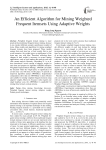
An Efficient Algorithm for Mining Weighted Frequent Itemsets Using Adaptive Weights
Статья научная
Weighted frequent itemset mining is more practical than traditional frequent itemset mining, because it can consider different semantic significance (weight) of items. Many models and algorithms for mining weighted frequent itemsets have been proposed. These models assume that each item has a fixed weight. But in real world scenarios, the weight (price or significance) of the items may vary with time. Therefore, reflecting these changes in item weight is necessary in several mining applications, such as retail market data analysis and web click stream analysis. Recently, Chowdhury F. A. et al. have introduced a novel concept of adaptive weight for each item and propose an algorithm AWFPM (Adaptive Weighted Frequent Pattern Mining). AWFPM can handle the situation where the weight (price or significance) of an item may vary with time. In this paper, we present an improved algorithm named AWFIMiner. Experimental computations show that our AWFIMiner is more efficient and scalable for mining weighted frequent itemsets using adaptive weights. Moreover, because it only requires one single database scan, the AWFIMiner is applicable for mining these itemsets on data streams.
Бесплатно
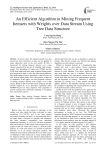
Статья научная
In recent years, the mining research over data stream has been prominent as they can be applied in many alternative areas in the real worlds. In [20], a framework for mining frequent itemsets over a data stream is proposed by the use of weighted slide window model. Two algorithms of single pass (WSW) and the WSW-Imp (improving one) using weighted sliding model were proposed in there to solve the data stream problems. The disadvantage of these algorithms is that they have to seek all data stream many times and generate a large set of candidates. In this paper, we have proposed a process of mining frequent itemsets with weights over a data stream. Based on the downward closure property and FP-Growth method [8,9] an alternative algorithm called WSWFP-stream has been proposed. This algorithm is proved working more efficiently regarding to computing time and memory aspects.
Бесплатно
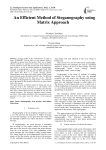
An Efficient Method of Steganography using Matrix Approach
Статья научная
A large number of the world business is going on using “INTERNET” and the data over the internet which is vulnerable for attacks from the hackers. Thus, uses of highly efficient methods are required for sensitive data transmission over the internet to ensure data security. One of the solutions to data security is to use an efficient method of steganography. The goal of steganography is to hide messages inside other ‘harmless’ messages in a way that does not allow any enemy to even detect that there is a second message present. Steganography can be used with a large number of file formats most commonly used in the digital world of today. The different file formats popularly used are .bmp, .gif, .txt etc. Thus the techniques of steganography are going to play a very important part in the future of data security and privacy on open systems such as the Internet. This paper presents an efficient method for hiding data into an image and send to the destination in a safe manner. This technique does not need any key for embedding and extracting data. Also, it allows hiding four bits in a block of size 5×5 with minimal distortion. The proposed algorithm ensures security and safety of the hidden information. The experimental results presented in this paper show the efficacy of the proposed method.
Бесплатно
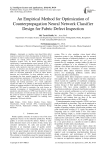
Статья научная
Automated, i.e. machine vision based fabric defect inspection systems have been drawing plenty of attention of the researchers in order to replace manual inspection. Two difficult problems are mainly posed by automated fabric defect inspection systems. They are defect detection and defect classification. Counterpropagation neural network (CPN) is a robust classifier and very promising for defect classification. In general, works reported to date have claimed varying level of successes in detection and classification of different types of defects through CPN; but in particular, no claimed has been made for successful application of CPN for fabric defects detection and classification. In those published works, no investigation has been reported regarding to the variation of major performance parameters of NN based classifiers such as learning time and classification accuracy based on network topology and training parameters. As a result, application engineer has little or no guidance to take design decisions for reaching to optimum structure of NN based defect classifiers in general and CPN based in particular. Our work focuses on empirical investigation of interrelationship between design parameters and performance of CPN based classifier for fabric defect classification. It is believed that such work will be laying the ground to empower application engineers to decide about optimum values of design parameters for realizing most appropriate CPN based classifier.
Бесплатно
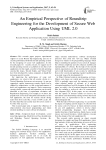
Статья научная
This research paper propose experimental support to secure Round Trip Engineering and use of security performance flexibility trusted operating systems for the designing of secure web applications. In this research paper, for security concern, we suggest use of trusted operating systems as a platform to run these web applications. In this regard, a number of trusted operating systems like Argus, Trusted Solaris, and Virtual Vault have been developed by various companies to handle the increasing need of security. For improving the performance of same web applications, we observe that all security checks in a Trusted Operating System are not necessary. As per our suggestion, various unnecessary security checks can be skipped by administrator, so that system performance of these web applications can improve. These unnecessary security checks, system calls and operations can be easily identified at the time of requirement elicitation and Requirement Engineering. For example, as we know, the popular web servers deal with public information. In this web application, the need for security checks during reads from disk seems like a waste of CPU cycles. On the other hand the real security need for servers seems to be of the write accesses. This research paper aims to support the efficiency of object-oriented class-based programming and object oriented modeling in secure software development.
Бесплатно
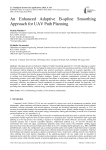
An Enhanced Adaptive B-spline Smoothing Approach for UAV Path Planning
Статья научная
This paper presents an Enhanced Adaptive B-Spline Smoothing approach for UAV path planning in complex three-dimensional environments. By leveraging the inherent local control and smoothness properties of cubic B-Splines, the proposed method integrates an adaptive knot selection mechanism—optimized via a genetic algorithm—with curvature-aware control point refinement to generate dynamically feasible and smooth flight paths. Simulation studies in a cluttered 3D airspace show that the proposed technique reduces path length and lowers maximum curvature compared to uniform and chord-length-based B-Spline strategies. Despite a moderate computational overhead, the results demonstrate smoother, more stable flight trajectories that adhere to aerodynamic constraints and ensure safe obstacle avoidance. This approach is particularly valuable for near-real-time missions, where flight stability, rapid re-planning, and energy efficiency are paramount. Results emphasize the potential of the proposed method for improving UAV navigation in various applications—such as urban logistics, infrastructure inspection, and search-and-rescue—by providing better maneuverability, reduced energy consumption, and increased operational safety to the UAV agents.
Бесплатно
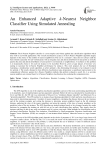
An Enhanced Adaptive k-Nearest Neighbor Classifier Using Simulated Annealing
Статья научная
The k-Nearest Neighbor classifier is a non-complex and widely applied data classification algorithm which does well in real-world applications. The overall classification accuracy of the k-Nearest Neighbor algorithm largely depends on the choice of the number of nearest neighbors(k). The use of a constant k value does not always yield the best solutions especially for real-world datasets with an irregular class and density distribution of data points as it totally ignores the class and density distribution of a test point’s k-environment or neighborhood. A resolution to this problem is to dynamically choose k for each test instance to be classified. However, given a large dataset, it becomes very tasking to maximize the k-Nearest Neighbor performance by tuning k. This work proposes the use of Simulated Annealing, a metaheuristic search algorithm, to select optimal k, thus eliminating the prospect of an exhaustive search for optimal k. The results obtained in four different classification tasks demonstrate a significant improvement in the computational efficiency against the k-Nearest Neighbor methods that perform exhaustive search for k, as accurate nearest neighbors are returned faster for k-Nearest Neighbor classification, thus reducing the computation time.
Бесплатно
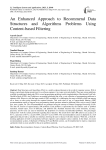
Статья научная
Data Structures and Algorithms (DSA) is a widely explored domain in the world of computer science. With it being a crucial topic during an interview for a software engineer, it is a topic not to take lightly. There are various platforms available to understand a particular DSA, several programming problems, and its implementation. Hacckerank, LeetCode, GeeksForGeeks (GFG), and Codeforces are popular platforms that offer a vast collection of programming problems to enhance skills. However, with the huge content of DSA available, it is challenging for users to identify which one among all to focus on after going through the required domain. This work aims to use a Content-based filtering (CBF) recommendation engine to suggest users programming-based questions related to different DSAs such as arrays, linked lists, trees, graphs, etc. The recommendations are generated using the concept of Natural Language Processing (NLP). The data set consists of approximately 500 problems. Each problem is represented by the features such as problem statement, related topics, level of difficulty, and platform link. Standard measures like cosine similarity, accuracy, precision, and F1-score are used to determine the proportion of correctly recommended problems. The percentages indicate how well the system performed regarding that evaluation. The result shows that CBF achieves an accuracy of 83 %, a precision of 83 %, a recall of 80%, and an F1-score of 80%. This recommendation system is deployed on a web application that provides a suitable user interface allowing the user to interact with other features. With this, a whole E-learning application is built to aid potential software engineers and computer science students. In the future, two more recommendation systems, Collaborative Filtering (CF) and Hybrid systems, can be implemented to make a comparison and decide which is most suitable for the given problem statement.
Бесплатно

An Evolving Cascade System Based on a Set of Neo - Fuzzy Nodes
Статья научная
Neo-fuzzy elements are used as nodes for an evolving cascade system. The proposed system can tune both its parameters and architecture in an online mode. It can be used for solving a wide range of Data Mining tasks (namely time series forecasting). The evolving cascade system with neo-fuzzy nodes can process rather large data sets with high speed and effectiveness.
Бесплатно

An Expert GIS-Based ANP-OWA Decision Making Framework for Tourism Development Site Selection
Статья научная
The selection of a tourism development site involves a complex array of decision criteria that may have interdependence relationships within and between them. In the process of finding the optimum location that meet desired conditions, the analyst is challenged by the tedious manipulation of spatial data and the management of multiple decision-making criteria. This paper presents a novel decision making framework in which expert systems (ES), and geographic information systems–based multicriteria evaluation techniques (Analytical Network Process and fuzzy quantifiers-guided ordered weighted averaging operators (GIS-based ANP-OWA)) are integrated systematically to facilitate the selection of suitable sites for building new tourism facilities. First, ES is used for recommending the proper site selection criteria and their interdependence relationships. Then, the GIS-based ANP-OWA is used to perform the spatial data analysis necessary to generate a wide range of possible candidate sites’ scenarios taking into accounts both the interdependence relationships between sitting criteria and the level of risk the decision-makers wish to assume in their multicriteria evaluation. A typical case study is presented to demonstrate the application of the proposed decision making framework.
Бесплатно

